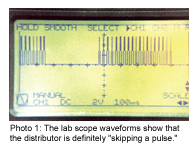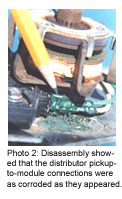Most diagnostic technicians have experienced the frustrations of troubleshooting temperature-related engine performance problems. All too often, the true nature of the problem is concealed by the very fact that it occurs only at specific engine temperatures. If the engine quickly passes through the critical temperature range needed to duplicate the problem, the problem can easily be overlooked or misinterpreted as an intermittent failure.
Before I get into my case studies, let’s study the warm-up process. An engine begins warming up the moment combustion heat penetrates through the cylinder head and dissipates into the engine’s coolant stream. At this point, the thermostat remains closed to prevent coolant from circulating through the engine’s radiator.
In order to distribute combustion heat evenly throughout the engine assembly, coolant is routed from the water pump through a bypass hose leading to the thermostat assembly. When bypass coolant reaches operating temperature, the thermostat begins to open, which allows hot coolant to circulate through the radiator.
Although the engine assembly itself warms up evenly, external components such as the intake manifold, fuel rail and ignition coil(s) may reach operating temperature only when the thermostat opens and underhood temperatures increase accordingly.
The Galloping Camaro
To illustrate my point, let’s look at a 1988 Chevrolet Camaro equipped with the 2.8L V6, VIN “S” multiport fuel-injection engine. With 44,975 miles on the odometer, the Camaro was in good condition for its age.
Nevertheless, service records show that this Camaro developed a very long and complicated service history. The owner’s original complaint was an intermittent check engine light and a surging problem at highway speed. The original trouble codes were DTC 14 (ECT voltage too low), DTC 15 (ECT voltage too high), DTC 21 (TP voltage too high), DTC 22 (TP voltage too low), DTC 23 (IAT voltage too high and (DTC 24 (no VSS signal).
The first four trouble codes had one common characteristic: all had DTCs indicating too high or too low of a voltage input to the PCM. An open circuit would normally cause high voltage while a shorted-to-ground circuit would normally cause low voltage. The IAT (intake air temperature) sensor and the VSS (vehicle speed sensor) failures did, however, demonstrate diagnostic logic. Intermittent vehicle speed sensor failures, for example, are common on older GM vehicles. A high-voltage intake air temperature trouble code can be created when a lube technician disconnects the IAT sensor with the ignition key on to change an air filter. Even at that, these four DTCs created the suspicion that I might be dealing with an intermittent ECM failure.
Starting from Scratch
At this point, I cleared the diagnostic memory and requested that the owner continue to drive the vehicle until the check engine light came on again. A few weeks later, the Camaro did return with the surging symptom and a DTC 34, which (keeping in mind that General Motors also used DTC 34 to indicate a MAP sensor failure in some engine applications) indicates that the mass airflow (MAF) sensor voltage was too low. In addition, the VSS DTC 24 was also present. The remaining DTCs didn’t reappear.
Testing early GM MAF sensors is relatively easy since at KOEO, they should generate a frequency between 8-10 hertz and a frequency of 40-45 hertz at warm idle. Since this MAF application is powered by a MAF relay located on the right front radiator core support, I also tested to make sure B+ voltage was available at the sensor. Because this MAF sensor had failed the KOEO and KOER frequency tests, I replaced it. With the exception of a very intermittent VSS sensor failure, this case should have been closed.
Multiple Failures
A few weeks later, the Camaro appeared with the same surging complaint but with no trouble codes to support a diagnosis. This time the MAF tested well on both KOEO and KOER frequency tests. However, upon starting the engine after an overnight cold soak, the check engine light immediately came on with a DTC 34 stored in the diagnostic memory. After replacing the MAF on warranty, I noticed that the engine developed a “rolling idle” or surge after about 20 minutes of closed-hood idling. On subsequent tests, the rolling idle would sometimes disappear and the engine would run well.
I also noticed that, when I connected a scan tool to retrieve DTCs and data, I had a “no-communication” issue with the ECM. I’m not going into detail because scan tool communications and false codes had been a historic issue with this vehicle. After testing the ECM’s power, ground and diagnostic connector, I tried to communicate with several other scan tools to no avail. At this point, I replaced the ECM with a reman unit.
The Warm-Up Lap
With the ECM lying on the floorboard and scan tool connected, I again noticed that the rolling idle condition developed after about 20 minutes of closed-hood operation. The scan tool was showing no DTCs and no defects in the serial data stream. Of course, with the hood closed and engine running, which external engine component would be one of the last to warm up? You guessed it — the distributor!
 A lab scope test of the distributor’s magnetic pickup assembly revealed that the pickup was skipping distributor reference signals (see Photo 1). The skipping reference signal caused a rapid, on-off spark condition. A further inspection of the distributor revealed that the pickup-to-module connection had some corrosion issues that might be causing an intermittent reference signal (see Photo 2). After wandering in a diagnostic wilderness of multiple component failures and false trouble codes, I found that a new module and pickup assembly cured this temperature-related “rolling idle” or “surging” complaint.
A lab scope test of the distributor’s magnetic pickup assembly revealed that the pickup was skipping distributor reference signals (see Photo 1). The skipping reference signal caused a rapid, on-off spark condition. A further inspection of the distributor revealed that the pickup-to-module connection had some corrosion issues that might be causing an intermittent reference signal (see Photo 2). After wandering in a diagnostic wilderness of multiple component failures and false trouble codes, I found that a new module and pickup assembly cured this temperature-related “rolling idle” or “surging” complaint.
 The Missing Intrepid
The Missing Intrepid
Like many modern “low-maintenance” vehicles, this 3.5L 1997 Dodge Intrepid was lagging far behind the factory-recommended maintenance schedule. At 165,000 miles, it appeared with an MIL issue and no driveability complaints. I found that a DTC P0305 or misfire on number-five cylinder had caused the MIL to illuminate. Since spark plug wear was severe, I checked the cylinder compression and installed new spark plugs. A month later, the Intrepid returned with the MIL on and the same DTC P0305 misfire issue.
Because the 3.5L engine utilizes a distributorless ignition, the list of suspect parts quickly seemed to narrow down to a bad spark plug wire, bad fuel injector or intermittent vacuum leak. The spark plug wire and fuel injector lab scope patterns didn’t reveal any faults. To make the issue more complicated, the engine idled perfectly with the right and left bank fuel trims hovering near zero. For the moment, I could rule out a vacuum leak. The freeze-frame data, however, proved much more intriguing. The DTC P0305 had been stored just as the vehicle had been placed in drive gear and moving with the engine slightly warmed up. Since I didn’t have any other diagnostic data, I cleared the DTC and asked the owner to continue to drive the vehicle.
Several weeks later, the Intrepid returned with the MIL on and the same DTC P0305 stored in the diagnostic memory. The previous and current freeze-frame data were virtually identical, indicating that the misfire was occurring just as the vehicle began moving with the engine slightly warmed up. Once in a great while, a cracked spark plug boot or carbon flash on the spark plug insulator can cause such a condition. This wasn’t the case, however, with the Intrepid. The only remaining cause was a vacuum leak. With that decided, I had to devise a strategy that would confirm my diagnosis.
After an overnight cold soak and with the misfire counter displayed on the scan tool, I started the engine. To my amazement, cylinders two and five began displaying misfires. Cylinder number two is located at the front of the driver’s side bank while cylinder five is located at the rear of the passenger side bank. As I suspected, the misfires began to fade away as the engine warmed up. Further complicating the issue, cylinders two and five are supplied with spark from the same ignition coil. In addition, the intake manifold to cylinder head gasket configuration is identical for both cylinders.
The Warm-Up Lap
After cooling the engine for an hour, I armed myself with a propane probe and duplicated the warm-up process. As cylinders two and five began to misfire, I slid the propane hose under the intake manifold. As the probe passed cylinder two, the left bank fuel trim numbers decreased. As the probe passed cylinder five, the right bank fuel trim numbers decreased. Obviously, although I had a vacuum leak on two cylinders, the PCM had stored a trouble code only for cylinder five.
After removing the intake manifold, the reason for the heat-related vacuum leak became clear. The OE gaskets are made of paper, which began to break up due to different thermal expansion rates between the engine block and intake manifold abrading the material. When the engine was completely cold or completely hot, the gaskets would seal. During the “warm-up lap,” however, they would separate enough to cause a temporary misfire. Is this a pattern failure? Probably so, since the aftermarket replacement gaskets are of a thicker, graphite-based material that allows slippage between the intake manifold and engine during warm up.
The Choking Cherokee
My final case study is a 4.0L 1998 Jeep Cherokee brought in by a used-car lot operator who had the vehicle sold if he could only “Get rid of this cold-running problem.” As you might suspect, the Jeep ran perfectly as I drove it into the shop. Preliminary testing didn’t reveal any trouble codes. However, I did leave my scan tool connected so I could observe the warm-up data.
The Warm-Up Lap
As the engine warmed up, the idle air control (IAC) valve suddenly began to groan as it opened up to prevent a stall. Racing to check the datastream on my scan tool, I noticed that the engine had reached 120




